FIVE GREAT GAMES
FOR THE ATARI
BY JOHN J. ANDERSON
|
AIR STRIKE
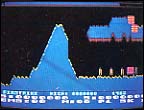
|
Up until just a few months ago, the only way you could get a copy of Air Strike was on cassette and through overseas mail. Its manufacturer, English Software, did not misrepresent itself--the company is located in England.
|
Now an office located in Redondo Beach is shipping Air Strike to stores in cassette and disk format. It is one of the better (and more challenging) Scramble type games available for the Atari.
By Scramble type game, I mean the following: a flyer-style shoot-'em-up, wherein the terrain scrolls by left to right. Your ship must move forward at all times, but you control altitude and speed. You can fire shots from your nosecone to vaporize enemy missiles, satellites and other debris (which is fatal on contact, so keep firing), and drop bombs to fill up at fuel depots you encounter along the way. Air Strike is but one of the games of this sort available for the Atari.
Using your joystick, you steer your ship and fire ahead. Using the spacebar, you bomb enemy fuel dumps and buildings. It is an acquired talent to manipulate joystick and spacebar simultaneously.
Warning: Air Strike is difficult. If you are a beginner or a "clod," as we occasionally label our own novice gamesters, Air Strike will frustrate the heck out of you in less than twenty minutes. By the time you manage to make it through the initial terrain scenario and into the portal containing the second, you have already spent hours training yourself in this phase of the mission. And things only get harder from here, so brace yourself.
The graphics in this package are fair, though the multicolor character graphics look a bit blocky to me. Perhaps it is because Air Strike runs in graphics 7 as opposed to graphics 7+ mode. The animation is likewise a bit ragged, with visible jumps here and there when interrupts coincide. In all, a good, but not excellent, effort.
If you like games of this ilk, however, Air Strike will not disappoint. Nor will it lose its challenge for quite a while.
ASTRO CHASE
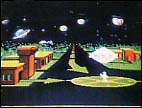
|
The other day associate editor Owen Linzmayer was on the phone with a non-computer-type member of the press, being grilled about his favorite arcade games. When asked what game of the last twelve months offered the best home computer graphics, he turned to me and asked "Astro Chase?" I nodded in agreement. Astro Chase really does look good.
|
But looking good does not make a games package. What is even more important is that it plays well, too.
You are engaged in interstellar war with enemy ships converging from all sides. The playfield is an impressive full-color, scrolling galaxy, with planet earth in the center. You can move in any of eight directions, until a force field at the rim of the galaxy turns you back. You need not fear collision with the force field or planets and stars, as your anti-matter engines will reverse upon contact with them. They must be navigated around, however, and careless navigation wastes precious time. The primary danger to your ship is contact with or fire drawn from enemy ships, and this is a real challenge, as their philosophy can be summed up in a single word: kamikaze. And that's not all.
Unless you are able to destroy the numerous death stars converging on the earth within the allotted time, the earth will be destroyed, and you along with it. Enemy cruisers will, of course, do their level best to deter you from your objective. You have mobility, firepower, and shields to aid you, but you will need unflagging vigilance to reach your goal. Do not stray too far from earth: leaving it unprotected for even a few seconds may spell its doom.
The package makes use of player/missile graphics, fine-scrolling, and four-voice Atari capability, which sets it far apart from interstellar shoot-'em-ups available for any other machines. The intermissions in Astro Chase are without question the best I have ever seen on the Atari computer. There you are, depicted as the astronaut beaming into your spaceship to do battle. Though the action is only tenuously connected with the main action, they are fun to watch, and provide a quick breather before the pressure of the next round ensues.
Astro Chase is by Fernando Herrera of First Star Software. The company is so-named because Herrera won the first big prize awarded by Atari to user-developed software. The award, known as the Atari Star, was given to Herrera for the educational program My First Alphabet, which has since been highly publicized. He has recently inaugurated his own software company, and if Astro Chase is indicative of the coming quality of its product line, he can expect to be very successful indeed. Astro Chase is a next-generation winner.
BURIED BUCKS
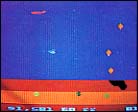
|
We don't see as much originality in video games as we have occasionally wished, but once in a while a package appears that takes a unique premise and develops it into a new game that bears little resemblance to anything that has come before. Buried Bucks, from Analog Software, fits this description and works its premise into an addictive arcade game.
|
In this game you are a helicopter pilot, carrying a supply of bombs with which you can strategically carve out screen terrain to reach valuable gold deposits. Your score in Buried Bucks is, appropriately, measured in dollars. A running total of the treasure-hunting expenditures you make is continually displayed, and as using a helicopter is an expensive proposition, your nest egg is whittled away quickly as you play.
By dropping bombs one on top of another from your hovering ship, you dig a trench down to the waiting lodes indicated by flashing dollar signs and located at various distances below the surface. Once a treasure is uncovered, you must carefully maneuver your chopper into the trench to pick it up. If you make it back to home base with the treasure, the monetary bonus is added to your score.
You can carry only so many bombs per run, as well. If you run out, you must return to base to reload. In the meantime, planes fly overhead, dropping great loads of dirt. The loads not only refill trenches where they hit, but can knock your chopper out of the sky. There is nothing you can do but keep dodging them as they fall. You are most vulnerable when descending into a trench to recover a treasure. Many a trench has become a helicopter gravesite.
As if there was not enough to worry about in Buried Bucks, boulders and floods also act to complicate the treasure retrieval process. If a trench fills with water, recovery of a treasure in that trench becomes impossible. Boulders defy destruction, and new routes, other than straight down, must be found around them to the treasures.
The level of graphics and sound in the program is utterly professional. As opposed to some other packages we have seen from Analog, that were frankly rather amateurish in their execution, Buried Bucks not only achieves an acceptable level of sound and animation, but provides a challenging and diverting game scenario. It is important in games of this kind to impart to the player a consistent sense of the "physical world" within the program. This package succeeds in creating that illusion, which in large part accounts for its success.
It would be fair to say that I "dig", Buried Bucks quite a bit.
CLAIM JUMPER
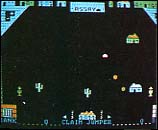
|
The main claim to fame of George Chang's Claim Jumper is that it is in the small but precious category of simultaneous two-player games. Instead of multiplayer modes wherein players take turns, both players share the Claim Jumper screen together. In fact, they are each other's worst enemies--doing whatever is feasible to stop an opponent's progress.
|
The goal here is gold, and the Old West is getting rather crowded. You must avoid all manner of obstacles while picking up nuggets, ferrying them to the assayer's office, and then lugging your gains to the safety of the bank. Your tools in this task are your trusty sixshooter, and a bizarre brand of seeds you may sew to liquidate pesky hangers-on. Enough dough in the bank secures a house (shades of Monopoly) and edges you closer to success. The first player to acquire 25,000 points is declared the winner.
Claim Jumper has a humorous mood about it, the graphics are crisp and stylish, and the pace is frenetic. Chances are you and your opponent will both be laughing by the middle of any game, even as the competition heats up.
If you are hit you end up in Boot Hill, and though you can be reincarnated endlessly, death wastes a lot of time. It also results in the dropping of any goods in your possession, to your opponent's immediate advantage. Depending on the level of aggression you choose to mete out to your opponent, you can either go about your prospecting business or blast the other guy just as he reaches the assayer, take his nugget, and keep it for yourself. Needless to say, he may choose to reciprocate with his own poor behavior.
The kids are bound to have a lot of fun with Claim Jumper, as it balances the right amounts of whimsy and competition. Although there is a solitaire version, it is of much less play value than the standard two-player game. The real fun comes when you are on the playfield with a human opponent.
DEFENDER
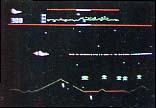
|
When an arcade game is transplanted to a home computer, certain compromises must be made. While many of us look forward to the day when micros with truly arcade-quality graphics make their way into the home, we do not expect current arcade translations to be utterly true to their namesakes. Raster scan technology, for one thing, disallows the superlative color graphics of a coin-op game on a home TV set.
|
I do, on the other hand, require an arcade translation to be true to the spirit, if not the letter, of its inspiration. Like literary translations, arcade translations must at the very least remain true to the feeling of the original work, or else real trouble ensues.
One real compromise that had to be made in bringing Defender to the home screen was that of joystick as opposed to push-button control. Short of marketing a custom peripheral along with the game (which is not unthinkable but would have added appreciable cost to the package), any new, joystick-oriented input configuration, regardless of its design, must alter the flavor of the game substantively.
And the solution found in Atari Defender does have its own flavor, although it is not by any means a bad one. For some I'm sure the new controller will make a formerly unplayable game playable. But to the purist, the only alternatives available are the purchase of a pushbutton controller and the homebrew design of a custom pushbutton controller. (See the November 1982 issue of Creative Computing for an article on this topic.) Otherwise game play will seem quite removed from the original.
In terms of the screen graphics provided by Defender, they are more than satisfactory. A real attempt has been made to capture the look of the arcade version, down even to the explosions. In fact, it looks to me as if bit-mapped players have been used in lieu of player/missile techniques, which would have been smoother, but have looked less like the coin-op game.
Defender is one of those "no time to inhale" shoot-'em-ups, of the kind that some people adore and others abhor. I was never much good at the arcade game, and while I loved the graphics as well as the sense of mobility the game afforded, my quarters were lost too quickly to foster a lasting relationship. I am much better at the home version, and the addictive pull is undeniably there. Defender is very good of its kind.
In case you have been living in Siberia for the past two years, allow me to describe for you the general scenario of the game. You are called upon to defend the surface of your planet from attacking aliens. The screen scrolls left or right, depending on your direction of flight, and you feverishly work to clear successive waves of the little beasties.
Meanwhile, the bad guys are intent on plucking innocent victims from the surface and changing them into malevolent drones. You must do all within your power to stop this dastardly habit. Carelessness will cost them their lives, but allowing their transformation is a fate worse than death. When things get really hot, you can detonate a smart bomb, but only once per wave.
It is very hard to avoid falling into a trancelike state while playing Defender, which results in your letting your guard down, and very quickly getting blown away. Keep blinking to avoid hypnosis, but don't blink too long--oblivion can strike in the bat of an eyelash.
Defender will most definitely keep you coming back for more.